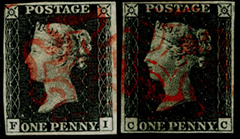 First Issues Collectors Club
of stamps and philatelic material
First Issues Collectors Club
of stamps and philatelic material
Home - Catalog - Categories - Index - Journal - Exhibits - Auctions - Forgeries - Join
 First Issues Collectors Club
of stamps and philatelic material
First Issues Collectors Club
of stamps and philatelic material
Home - Catalog - Categories - Index - Journal - Exhibits - Auctions - Forgeries - Join
| first issues > countries > afghanistan |
| Asia | 3 |
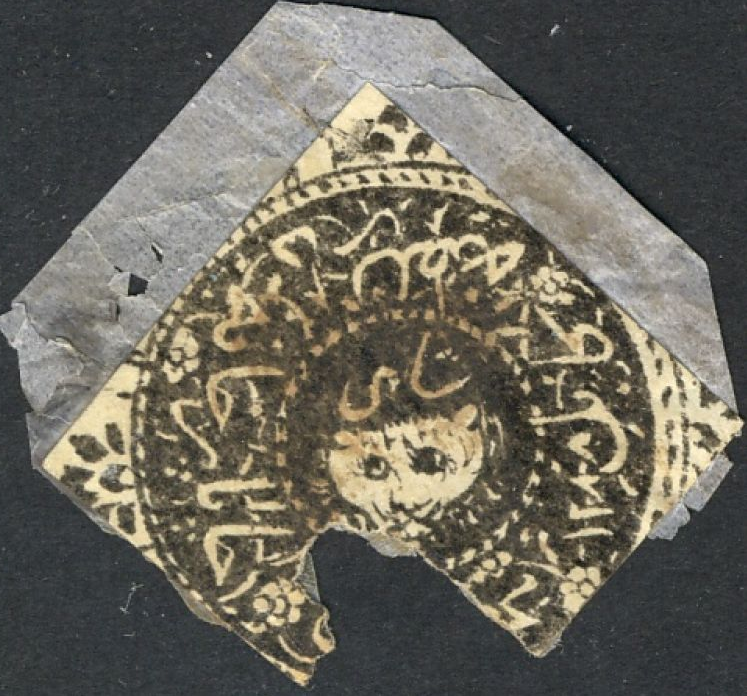 |
||
| Afghanistan Sc1, SG1, YT2 | ||
imperf, no wmk, lithographed Printed locally |
||
| The stamp shown is from
David Olson's web site and is described as, “Tiger's head. On a small piece. Torn to cancel as customary. Both the inner and the outer circles are uniformly dotted. Denomination is one shahi located within the inner circle above the tiger's head. Dated "1288" Moslem year, outside the inner circle to the right of the tiger's head. Diameter at the outer line is 30-mm.” |
||
| Catalogue Entries for 1871 (1288) issues | |||||
| Description | Scott# [1] | SG# [3] | Mi# [4] | Y&T# [5] | Mink [6] |
|---|---|---|---|---|---|
| Outer circle 30mm (SG Plate A) | |||||
| 1 shahi black | 1 | 1 | 2 | 1t |
|
| Outer circle 28 mm, both circles dotted (SG plates B and C) | |||||
| 1 shahi black | 2 [2] | 2, 3 | 2a, 2b | 1, 1t1 |
|
| 1 sanar black | 3 | 5, 6 | 3, 3a | 2, 2t |
|
| 1 abasi black | 4 | 8 | 4 | 3 |
Inner circle continuous (SG Plate D) |
| 1 shahi black | 5 [2] | 4 | 2c | 1t2 |
|
| 1 sanar black | 6 | 7 | 3b | 2t1 |
|
| 1 abasi black | 7 | 9 | 4a | 3t |
|
Summarising across the catalogues is difficult. Gibbons and Yvert & Tellier are consistent, but Scott used not to differentiate between 28mm and 30mm outer circles: this only changed in 2016.
Gibbons does distinguish between Plates B and C in respect of the width of the outer circle, but that is not reflected in the table above.
Mackay's Classic Stamps [JM1] covers the period 1840 until 1870, but he stretches a point to include Afghanistan,
Afghanistan's neighbours - India, Russia and Persia - had all adopted adhesive stamps, and at the very end of the classic period the practice was extended to this remote kingdom. The first stamps were circular in shape and their design, showing a lion's head surrounded by the inscription in Arabic lettering, was reminiscent of the stamps of Jammu and Kashmir. The stamps bore the date 1288 in the Moslem calendar; since this corresponds with 1870-71 in the Christian calendar it is just possible that the stamps did not appear till 1871, but one must give them the benefit of the doubt and include them with the classics.
The stamps, in various denominations from 1 shahi to 1 abasi, were lithographed together on the same plates … Circular stamps remained in use in Afghanistan until 1890, though the rectangular format had demonstrated its convenience and had been adopted practically everywhere else. As regards the cancellations of stamps Afghanistan was also a law unto itself. Instead of using a postmark or pen-cancellation, it was customery for postal clerks to lift a corner of the stamp from the letter and tear out a piece. Thus Afghan stamps in damaged condition are quite collectable, since it indicates that they have been postally used. [This form of cancellation was also used in Madagascar British Consular Mail issues, not yet detailed.]
What follows is an attempt to explain the issues.
| Attribute | Source | Description | Illustration |
|---|---|---|---|
| Currency (1871-1920) | SGP4, YTC | 60 Paisa =12 Shahi = 6 Sanar = 3 Abasi = 2 Kran = 1 Rupee The ordinary rupee of raw silver was worth 60 paisa but there was also a Kabali sterling rupee of refined silver worth 66 paisa. Yvert & Tellier refers to the "sunar" rather than the "sanar". |
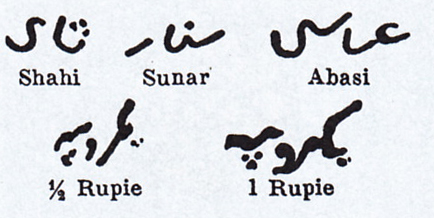 |
| Plates (see note 5) | SGP4 | Gibbons distinguishes between four plates, noting that "each position on the plate [was] individually drawn". Plate A - Both circles dotted, outer circle diameter 30mm, plate entirely of 1 shahi stamps (15). Plate B - Both circles dotted, outer circle diameter 28mm, 10x1 shahi and 5x1 sanar stamps. Plate C - Worn state, both circles dotted, outer circle diameter 28mm and narrower than PlB, 5x1 shahi, 5x1 sanar and 5x1 abasi stamps. Plate D - Outer circle dotted, "inner circle round lion's head plain", 5 of each stamp. |
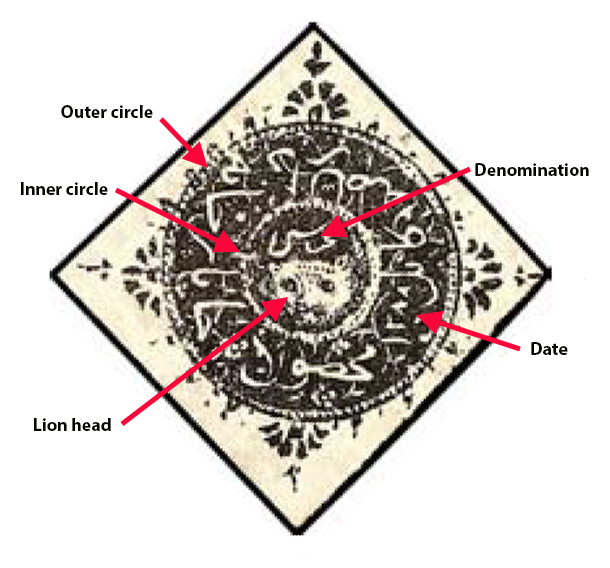 |
| Dates | JM1, YTC | As Mackay has described, the issues use the Mohammedan calendar and so the first year of issue are inscribed '1288'. | 
 |
| Paper | ScC, SGP4 | Scott notes that stamps until 1878 "are on laid paper of varying thickness except where wove is noted". Wove is noted for the 1872 issues. Gibbons lists "medium laid paper, white to yellowish" for SG1-SG9 and "thin yelowish wove paper" for the 1872-73 issues. | |
| Design | Stamps without the lion head in the middle are revenues. There is much discussion over whether it is a lion's head or a tiger's head. |
| Notes | |||||||
|---|---|---|---|---|---|---|---|
1 |
There was no Sc1 for a long time. This page was based on Scott Classic 2004, which starts at Sc2, but I am advised by David Olson that the Scott catalogue published in 1897 had an 1868 mauve Sc1; the Scott catalogue for 1903 started at Sc2; and (as far as we know) it stayed that way until 2016 when the Sc1 30mm outer was introduced. | ||||||
|
|||||||
2 |
Scott (2004) states that there are 30 varieties of the 1sh stamp (Sc2), 10 varieties of the Sc3 and 5 of the Sc4. There are 5 varieties each of stamps Sc5-Sc7. Gibbons SGP4 notes that "each position on the plate [was] individually drawn". | ||||||
3 |
The Gibbons configuration |
||||||
4 |
No Michel catalogue covering Afghanistan is available to the author at the time of writing (March/April 2016). | ||||||
5 |
There is no YT1. The Yvert & Tellier approach is also plate-based (translated), "There are 4 plates of 1sh : 3 of 1sa, 2 of 1ab. On Plate A (1sh) the circle measures 30mm; on the others 28mm. On Plates B and C, the inner circle is dotted; on Plate D it is continuous." That matches Gibbons. | ||||||
6 |
Minkus identifies the four plates but differentiates the second and third by outer rings of 28mm and 27.5mm and the numbering system is unwieldy
|
Identification
Tim Balm (editor of the FICC Journal and Manager of the FICC Auction) offered the following advice in the (now defunct) FICC Forums.
Test 1: Does it have 4 large ornaments at 90 degree positions around the outer edge. If so, then it is from Sc#2-Sc#10. If the stamp is cut close around, pass on it.
Test 2: This is the one Jesper [the original web master of this site] has cited from Scott. Are there dots in the inner circle around the tiger's head. This is absolutely necessary. This narrows it to Sc#2-Sc#4.
Test 2a: The ornaments at the 12:00, 3:00, 6:00 and 9:00 positions should have 3 "leaves" at the outer edge. Subsequent varieties do not have these. This helps confirm Sc#2-4
Test 2b: The Islamic calendar date (1288) should be located between the 3 o'clock and 4 o'clock position -- mid way between the inner dotted circle and the outer dotted circle. It might be easier to study the picture in the Scott catalog (graphic A2 under Afghanistan). This confirms only that you are in Sc#2-Sc#7. [The 1289 dates for Sc#8-9 are found between the 11:00 and 12:00 positions. The 1290 dates for Sc#10 are extremely poorly readable, but located in the 4:00 position.]
Test 2c: An easy test to sort out the Sc#8-9 stamps is that the outer large ornaments are located at the 1:30, 4:30, 7:30 and 10:30 positions.
Now you have to distinguish between Sc#2, 3 and 4. The denominations are located inside the inner circle, right above the tiger's head. These take a fair bit of agonizing. The 1 shahi denomination stamp is shown in graphics A2 and A5 under Afghanistan (in my Scott 2000 catalogs). The 1 sanar denomination is best shown above the tiger head in graphic A6. The 1 abasi denomination is similar to the 1 shahi - it is shown in graphic A3
We have not even touched upon the forgeries of these stamps. This is very ugly in that there are 5 major varieties of the Sc#2 - all with different numbers of dots in the outer circle that range from 77 to 86 dots. All in all, this is the job for a true expert.
Tim adds the following advice, "All free advice carries a money-back guarantee." These tests are not likely "fool-proof" because I've been shown too many times what things fools can do with my advice/guidance.
Changes of Administration
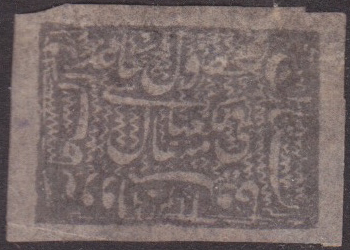 |
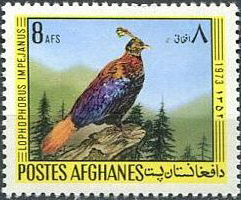 |
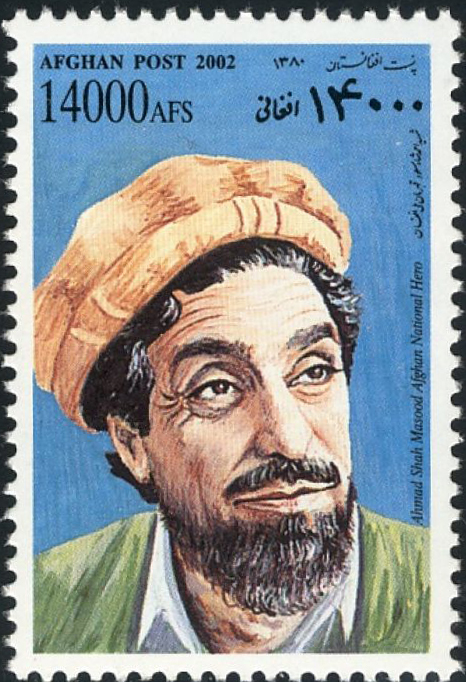 |
Kingdom of Afghanistan |
Republic |
Transitional Islamic State |
| 1891 [1309] Sc177 SG144 Mi YT193 Mink69 1ab grey-blue |
1973 Sc883 SG751 YT982 Impeyan pheasant |
2002 Sc1384 SG |